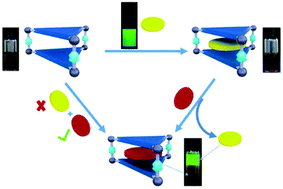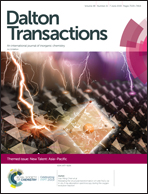On/off fluorescence emission induced by encapsulation, exchange and reversible encapsulation of a BODIPY-guest in self-assembled organometallic cages†
Abstract
A dynamic guest-binding study of BODIPY-derivative 3 (3 = 1,3,5,7,8-pentamethyl-4,4-difluoro-4-bora-3a,4a-diaza-s-indacene) with two Cp*RhIII-based organometallic cages [Cp*6Rh6(μ-CA)3(tpt)2](OTf)61 (H2CA = chloranilic acid, tpt = 2,4,6-tripyridyl-1,3,5-triazine) and [Cp*6Rh6(μ-DHNA)3(tpt)2](OTf)62 (H2DHNA = 6,11-dihydroxynaphthacene-5,12-dione) have been demonstrated. While guest 3 displays a strong green fluorescence emission, the host–guest complexes 3⊂1 and 3⊂2 exhibit almost no emission. However, fluorescence emission can be again ‘turned on’ by adding coronene (4) or pyrene (5) into the solution of 3⊂1 and 3⊂2. Guests 4 and 5 show stronger binding affinities toward the organometallic cages 1 and 2 due to the strong electrostatic interactions between the electron-rich guest and electron-deficient tpt resulting in the displacement of 3 by 4 or 5, which eventually helps the fluorescence enhancement. Further guest-binding studies using a Job's plot experiment illustrate the formation of discrete 1 : 1 host–guest complexes which are also supported by 1H NMR spectroscopy and ESI mass spectrometry. The anion-exchange study with sodium chloride reveals that the chloride ion can effectively disassemble the host frameworks of 1 and 2 releasing the fluorescent guest 3 which can be again encapsulated into the cavity of reassembled cages promoted by the addition of silver triflate.

- This article is part of the themed collections: Spotlight Collection: Metallocycles and Metallocages and New Talent: Asia-Pacific


 Please wait while we load your content...
Please wait while we load your content...